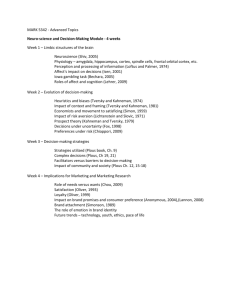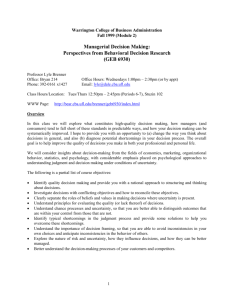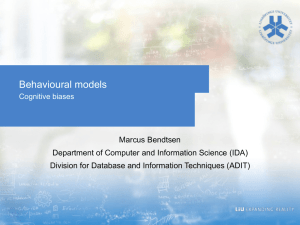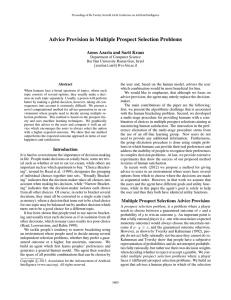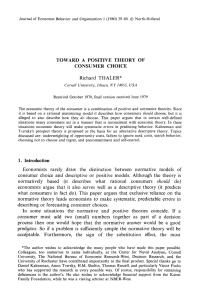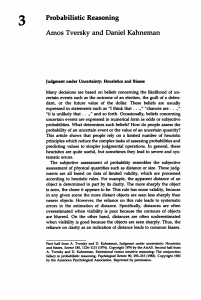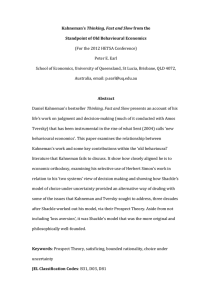Risk-taking in academic libraries: the implications of
advertisement
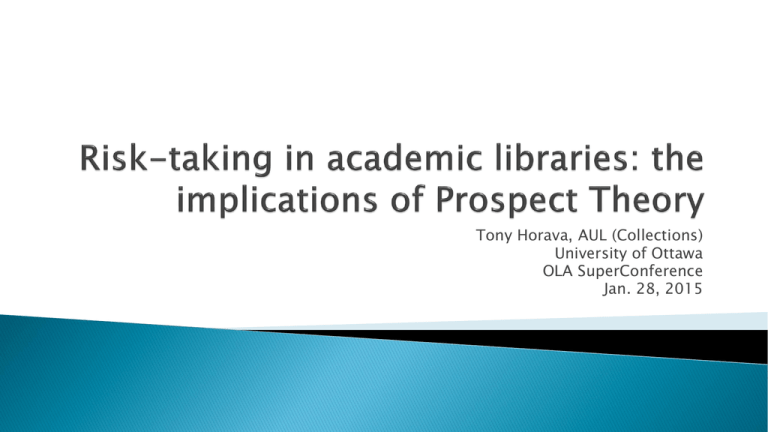
Tony Horava, AUL (Collections) University of Ottawa OLA SuperConference Jan. 28, 2015 Organizational risk Prospect Theory Major principles Implications for risk assessment Implications for academic libraries Conclusion http://cache2.assetcache.net/gp/108113005.jpg?v=1&c=IWSAsset&k=3&d=awa M4LoT7hBkpnWMaZOi86ZN5uTph2KW34WXjDY%2fRL2UfTKpg 7wZzBTEKgLqfqxS https://encryptedtbn1.gstatic.com/images?q=tbn:ANd9GcQy-5w9ScJN3T7GUeALRugf6pBpyBJE9MmTQa6EpB0EZz 1qYh4 “Society values risk taking but not gambling, and what is meant by gambling is risk taking that turns out badly. From the point of view of managers and a society dedicated to good management, the problem is to develop and maintain managerial reputations for taking "good" (i.e., ultimately successful) risks and avoiding "bad" (i.e., ultimately unsuccessful) risks, in the face of (possibly inherent) uncertainties about which are which.” James G. March and Zur Shapira, “Managerial Perspectives on Taking,” Management Science 33, no. 11 (1987): 1413. Risk and Risk The ARL 2030 Scenarios : A sustained reflection upon the risks and opportunities for libraries, based on four possible scenarios. It is up to each library to assess the probability of any scenario occurring “Organizations act on what they know or what they believe they know to be certain. Many of those certainties are in actuality uncertainties. Those false certainties become the basis for an organization’s strategic decision-making. “ Frames - lenses that filter some things and allow others to pass through, help us order experience. Each frame comes with concepts and metaphors for organizing our understanding of the world, esp organizational culture Four frames – Structural; Human resource; Political; Symbolic Looking at organizations this way can help us assess what is working and what isn’t – and addressing risk in reframing Technological - rapid obsolescence and the hype cycle; inadequate or dysfunctional tools; lack of interoperability with other systems; foreshortened life cycles for development; the quality of maintenance and support Financial - the institution’s degree of support of the library; the foreign exchange rate; Ontario’s and Canada’s economic performance; investments made by the institution; the global economy & inflation http://wilderdom.com/images/Ris kNotTakingRisksCartoon.jpg Political institutional strategic agendas shifting in direction; changes in senior administration and therefore shifting loyalties and power balances; a range of stakeholders in the academy with different/complementary interests; Assessment standards and measurement of impacts; unpredictable directions/pressures for post-secondary education; new governments with new agendas Socio-cultural – new patron attitudes and preferences in their use of information and devices; new learning styles based on use of social media and new technologies; new purposes for using library spaces and collections, such as collaborative work shifting demographics that can lead to a new mix of the student population; Mental paradigms affect risk assessment and decision-making in libraries. The historian of science Thomas Kuhn asserted that a paradigm is "the entire constellation of beliefs, values, techniques, and so on shared by the members of a given community.” - In a library context, this constellation is typically conservative, reactive, and risk-averse (but changing…) The importance of process: "The less things are predictable the more attention you have to pay to the strategy process. Uncertainty has the effect of moving the key to success from "the optimal strategy" to the "most skilful strategy process.” Kees van van der Heijden, Scenarios: The Art of Strategic Conversation vii-viii. “Prospect Theory: An Analysis of Decision under Risk” Econometrica 1979 47(2): 263-291. http://www.princeton.edu/~kahneman/docs/Publications/pro spect_theory.pdf The authors Daniel Kahneman and Amos Tversky, awarded the Nobel Prize for Economics in 2002 Originally applied to behavioral economics; then applied to other contexts Has led to a more nuanced understanding of how we grapple with uncertainty and make decisions in the face of risk. Probability weighting Reference dependence; Loss aversion; Diminishing sensitivity; The role of probability weighting in decision-making is quite crucial. Typically, “the weighting function overweights low probabilities and underweight high probabilities.” Generally speaking, people are overconfident about expected outcomes related to risk, and make decisions with particular biases Interview with Daniel Kahneman: ◦ “People systematically violate the predictions of expected utility theory.” ◦ “The emotional tail wags the rational dog” People derive utility from gains and losses, measured relative to some reference point, rather than from any absolute standard for economic well-being. All gains and losses are therefore relative; no one size fits all Think of your Collections budget, or Operations budget, or staff complement, as the reference point for your library’s experience in any given year – versus previous years. Loss aversion - people are much more sensitive to losses— even small losses—than to gains of the same magnitude, eg “people tend to be risk averse over moderate probability gains: they typically prefer a certain gain of $500 to a 50 percent chance of winning $1,000.” People hate losing much more than they love winning (by a factor of about 2-3 to 1, based on Kahneman and Tversky’s research) - Replacing a $100 gain (or loss) with a $200 gain (or loss) has a significant utility impact, replacing a $1,000 gain (or loss) with a $1,100 gain (or loss) has a smaller impact. As numbers scale upward – think of budgets or collectionsthis implies that we become less sensitive to the impact that variations from expectations can produce A serial that costs $100 this year and jumps to $500 next year is seen as a dramatic increase, versus a serial that costs $5,000 this year and $5,400 next year. Scale of perception is different. Kahneman and Tversky asked subjects to choose between the following two options: A) a 5% chance to win a three-week trip to England, France and Italy; or B) a 10% chance to win a one week trip to England. 67% of participants chose Option A, and 33% chose B, even though the odds are in favour of B. In a second test, subjects were asked to choose between the following two options: A) a 20% chance to win a gamble for $4,000; or B) a 25% chance to win a gamble for $3,000 Result: 65% of participants chose Option A, and only 35% chose B, even though the odds are in favour of B. Collection strategies, eg the possible end of the Big Deal Funding challenges/existential threats The galloping horse of technology Transformation of services Contingencies such as natural disasters Collaborative projects Staffing shortfalls Etc.... Can these principles be useful in our mental toolkit for decision-making, ie in a climate where increasingly difficult choices will need to be made (coming to terms with losses or tradeoffs) Prospect Theory can make us more aware of our default ways of understanding risk It speaks to the importance of making decisions using evidence-based approaches, both for short and long term planning Risk is baked in to the academic world, and increasing in intensity with each year The more aware we are of risk dynamics, the better equipped we are with dealing with tough constraints and choices. Reviewing the full spectrum of high and low risk events & factors, in relation to our understanding of probability and contingency, is valuable. Prospect Theory can provide us with some insights on human decisionmaking under risk. Can this transfer to our world and be useful? “Risk-taking in Academic Libraries: The Implications of Prospect Theory” Library Leadership & Management 28(2) 2014. https://journals.tdl.org/llm/index.php/llm/article/view/7055 http://itsadeliverything.com/wordpress/image s//assumption-means-risk.png Tony Horava thorava@uottawa.ca (613) 562-5800 ext 3645


